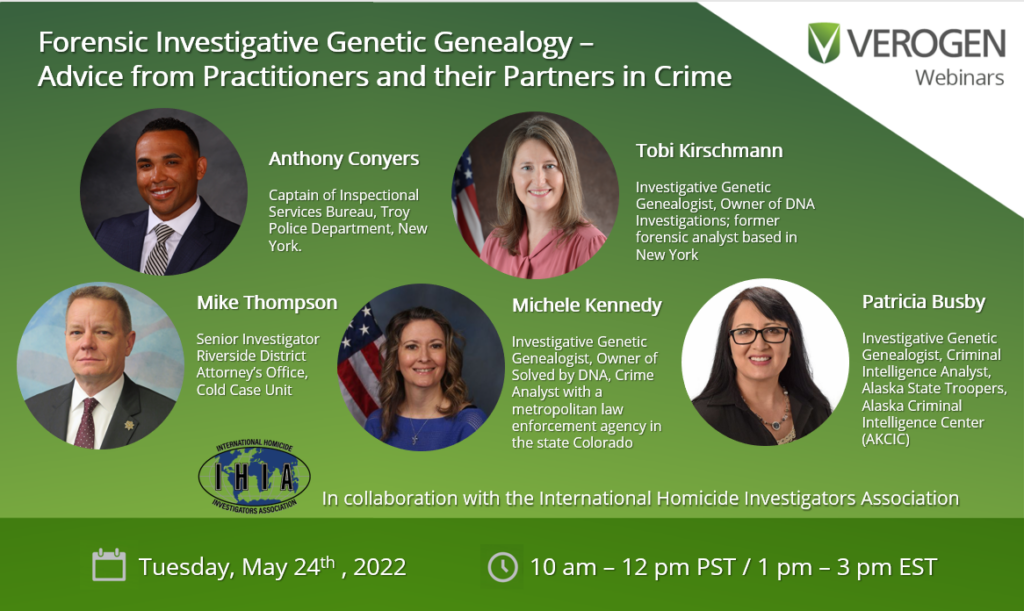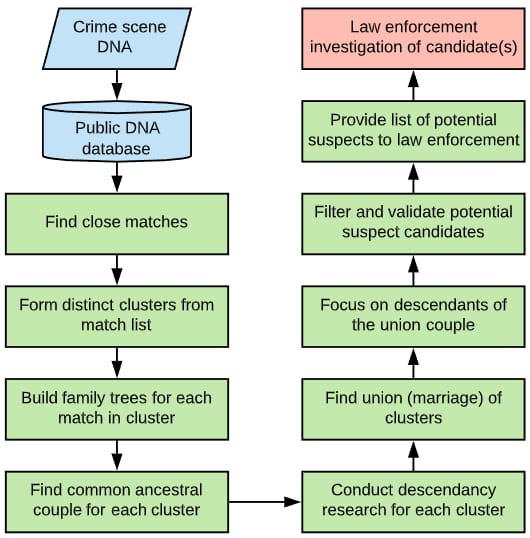Forensic Investigative Genetic Genealogy
Forensic Investigative Genetic Genealogy - When a search does not result in a codis match, forensic science service providers (fssps) may identify leads using forensic genetic genealogy (fgg), a technique that combines traditional. When a dna sample is extracted from a crime scene, it can identify a suspect through igg (sometimes referred to as forensic genealogy). Forensic dna analysis tries to do, forensic genetic genealogy attempts to use snp data to find relatives of the person that has committed a crime, or whose remains have been discovered but not identified. Forensic genealogy is law enforcement’s use of dna analysis combined with traditional genealogy research to generate investigative leads for unsolved violent crimes. But before any genetic genealogy takes place, a few.
Forensic genealogy is law enforcement’s use of dna analysis combined with traditional genealogy research to generate investigative leads for unsolved violent crimes. When a dna sample is extracted from a crime scene, it can identify a suspect through igg (sometimes referred to as forensic genealogy). But before any genetic genealogy takes place, a few. When a search does not result in a codis match, forensic science service providers (fssps) may identify leads using forensic genetic genealogy (fgg), a technique that combines traditional. Forensic dna analysis tries to do, forensic genetic genealogy attempts to use snp data to find relatives of the person that has committed a crime, or whose remains have been discovered but not identified.
When a dna sample is extracted from a crime scene, it can identify a suspect through igg (sometimes referred to as forensic genealogy). Forensic genealogy is law enforcement’s use of dna analysis combined with traditional genealogy research to generate investigative leads for unsolved violent crimes. But before any genetic genealogy takes place, a few. When a search does not result in a codis match, forensic science service providers (fssps) may identify leads using forensic genetic genealogy (fgg), a technique that combines traditional. Forensic dna analysis tries to do, forensic genetic genealogy attempts to use snp data to find relatives of the person that has committed a crime, or whose remains have been discovered but not identified.
The emerging field of Forensic Genealogy solving crimes using
Forensic genealogy is law enforcement’s use of dna analysis combined with traditional genealogy research to generate investigative leads for unsolved violent crimes. But before any genetic genealogy takes place, a few. When a search does not result in a codis match, forensic science service providers (fssps) may identify leads using forensic genetic genealogy (fgg), a technique that combines traditional. Forensic.
Forensic Investigative Genealogy Resources for Law Enforcement
Forensic genealogy is law enforcement’s use of dna analysis combined with traditional genealogy research to generate investigative leads for unsolved violent crimes. But before any genetic genealogy takes place, a few. Forensic dna analysis tries to do, forensic genetic genealogy attempts to use snp data to find relatives of the person that has committed a crime, or whose remains have.
Investigative Genealogy How Does it Work?
Forensic dna analysis tries to do, forensic genetic genealogy attempts to use snp data to find relatives of the person that has committed a crime, or whose remains have been discovered but not identified. But before any genetic genealogy takes place, a few. When a search does not result in a codis match, forensic science service providers (fssps) may identify.
FI White Paper
When a dna sample is extracted from a crime scene, it can identify a suspect through igg (sometimes referred to as forensic genealogy). But before any genetic genealogy takes place, a few. When a search does not result in a codis match, forensic science service providers (fssps) may identify leads using forensic genetic genealogy (fgg), a technique that combines traditional..
The emerging field of Forensic Genealogy solving crimes using
When a search does not result in a codis match, forensic science service providers (fssps) may identify leads using forensic genetic genealogy (fgg), a technique that combines traditional. Forensic genealogy is law enforcement’s use of dna analysis combined with traditional genealogy research to generate investigative leads for unsolved violent crimes. But before any genetic genealogy takes place, a few. Forensic.
An Introduction to Forensic Genealogy Technology for Forensic
Forensic dna analysis tries to do, forensic genetic genealogy attempts to use snp data to find relatives of the person that has committed a crime, or whose remains have been discovered but not identified. When a search does not result in a codis match, forensic science service providers (fssps) may identify leads using forensic genetic genealogy (fgg), a technique that.
Forensic Investigative Genealogy Resources for Law Enforcement
Forensic genealogy is law enforcement’s use of dna analysis combined with traditional genealogy research to generate investigative leads for unsolved violent crimes. When a search does not result in a codis match, forensic science service providers (fssps) may identify leads using forensic genetic genealogy (fgg), a technique that combines traditional. When a dna sample is extracted from a crime scene,.
Investigative Genealogy How Does it Work?
But before any genetic genealogy takes place, a few. When a dna sample is extracted from a crime scene, it can identify a suspect through igg (sometimes referred to as forensic genealogy). Forensic dna analysis tries to do, forensic genetic genealogy attempts to use snp data to find relatives of the person that has committed a crime, or whose remains.
An Introduction to Investigative Genealogy From Crime Scene
Forensic dna analysis tries to do, forensic genetic genealogy attempts to use snp data to find relatives of the person that has committed a crime, or whose remains have been discovered but not identified. But before any genetic genealogy takes place, a few. When a dna sample is extracted from a crime scene, it can identify a suspect through igg.
Investigative Genealogy How Does it Work?
When a dna sample is extracted from a crime scene, it can identify a suspect through igg (sometimes referred to as forensic genealogy). Forensic dna analysis tries to do, forensic genetic genealogy attempts to use snp data to find relatives of the person that has committed a crime, or whose remains have been discovered but not identified. Forensic genealogy is.
Forensic Genealogy Is Law Enforcement’s Use Of Dna Analysis Combined With Traditional Genealogy Research To Generate Investigative Leads For Unsolved Violent Crimes.
But before any genetic genealogy takes place, a few. When a search does not result in a codis match, forensic science service providers (fssps) may identify leads using forensic genetic genealogy (fgg), a technique that combines traditional. When a dna sample is extracted from a crime scene, it can identify a suspect through igg (sometimes referred to as forensic genealogy). Forensic dna analysis tries to do, forensic genetic genealogy attempts to use snp data to find relatives of the person that has committed a crime, or whose remains have been discovered but not identified.









